Unit 4 A good read Grammar 课件(29张PPT)
文档属性
| 名称 | Unit 4 A good read Grammar 课件(29张PPT) | 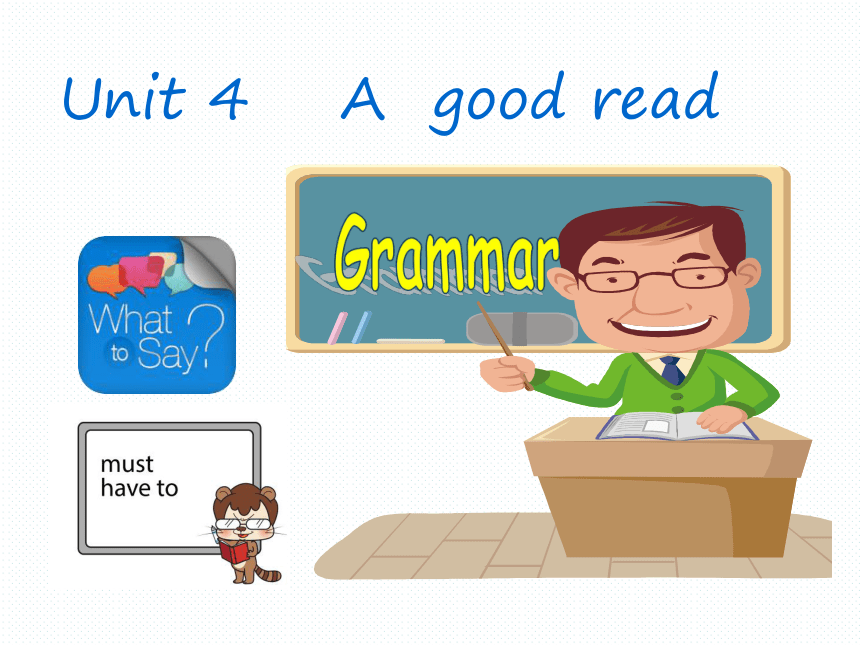 | |
| 格式 | ppt | ||
| 文件大小 | 1.6MB | ||
| 资源类型 | 教案 | ||
| 版本资源 | 牛津译林版 | ||
| 科目 | 英语 | ||
| 更新时间 | 2021-03-18 20:27:46 | ||
图片预览

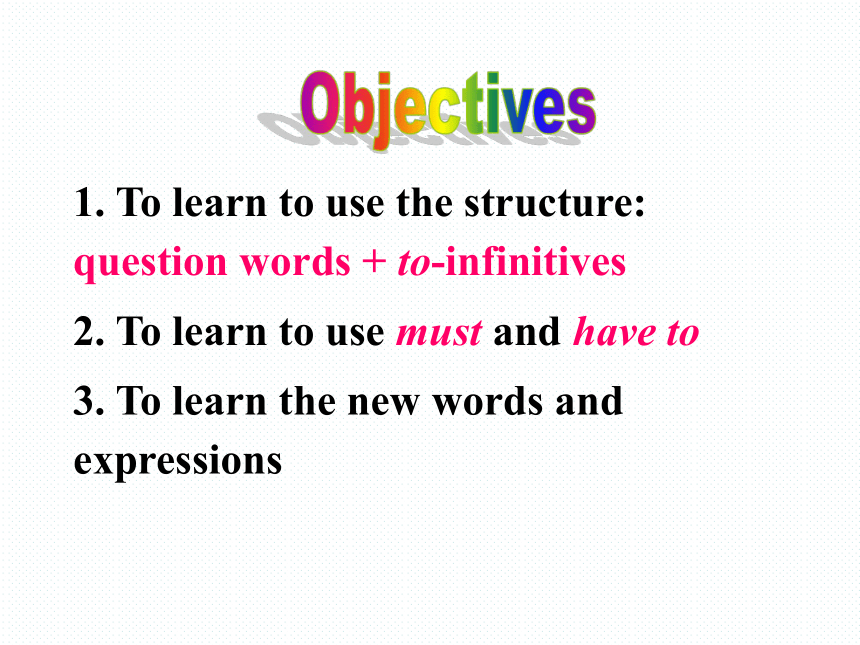
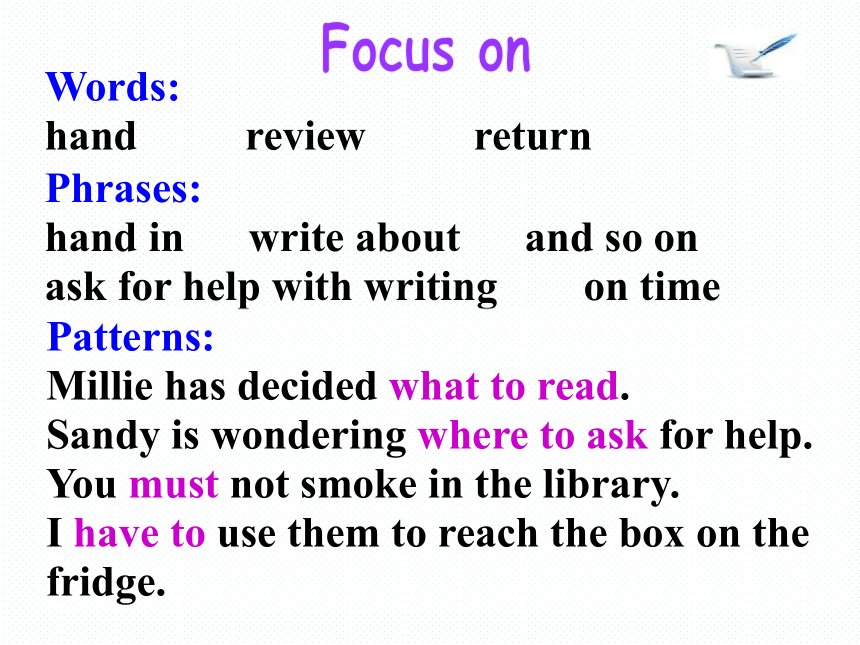
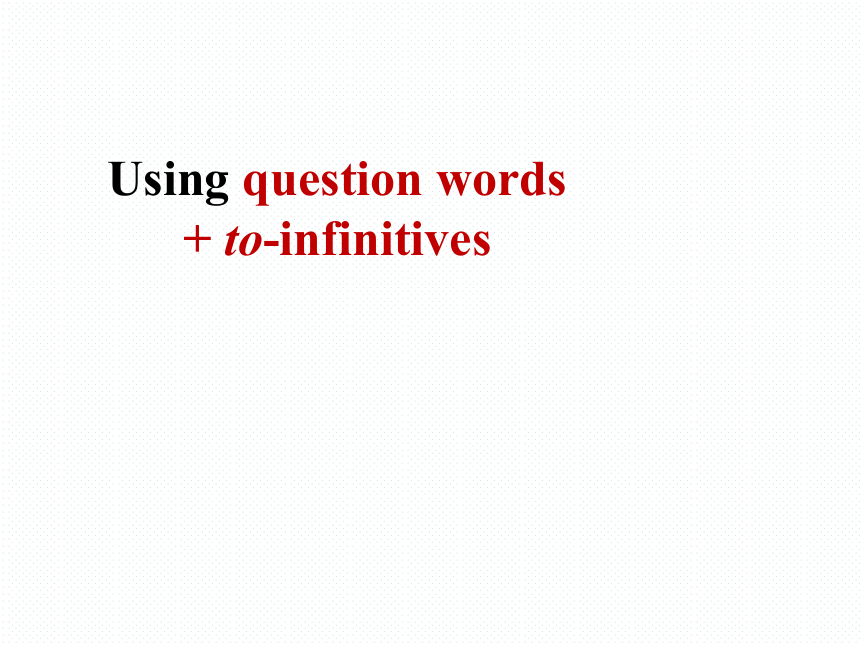
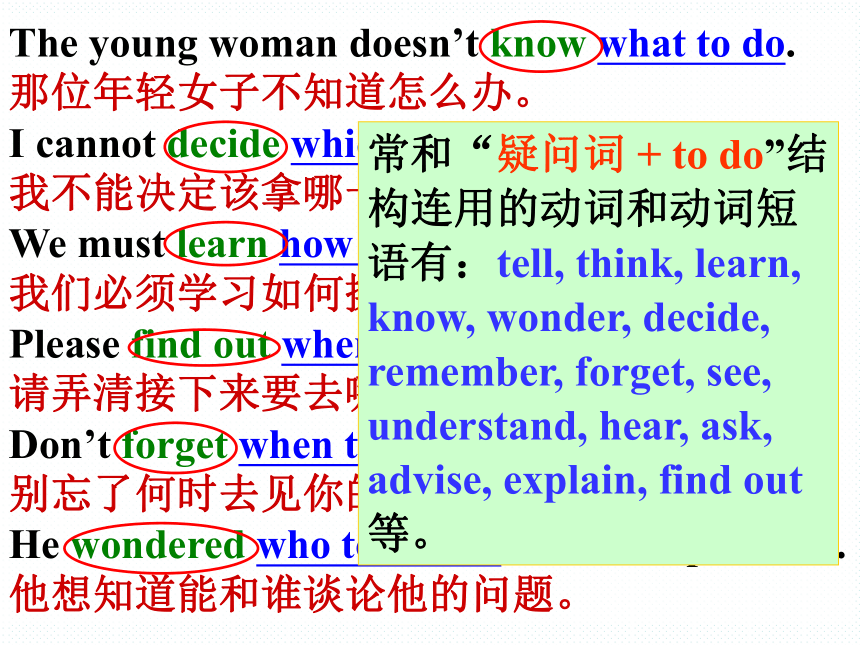
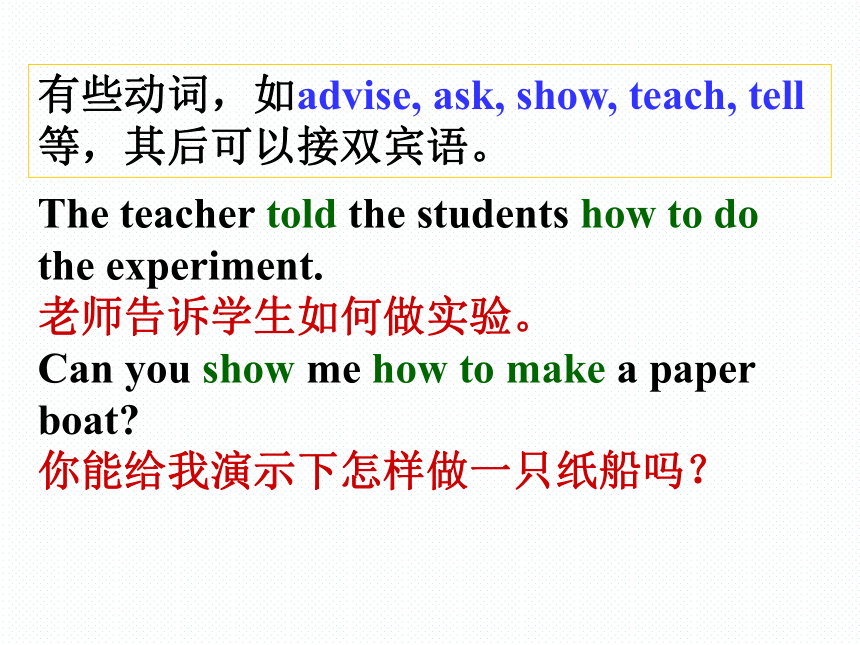
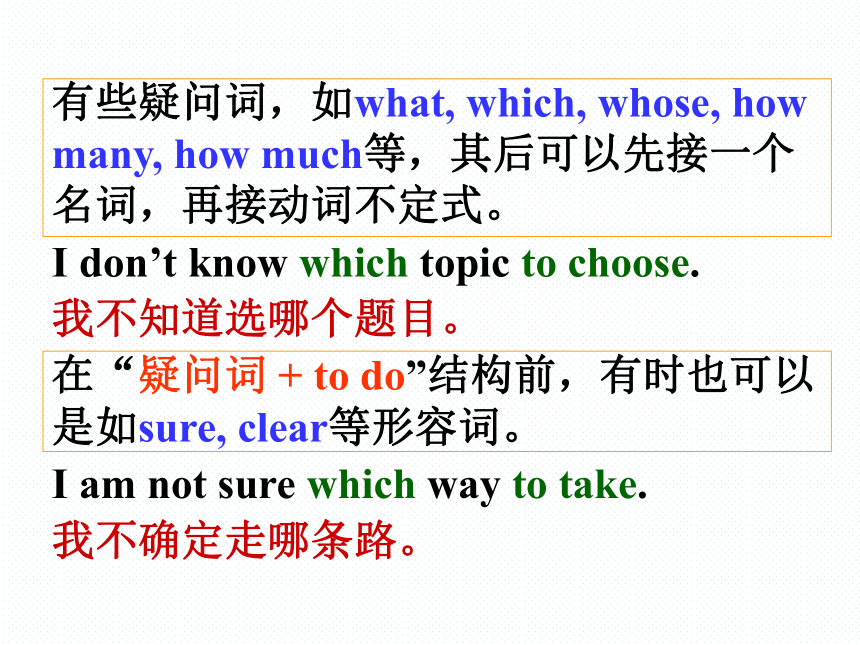
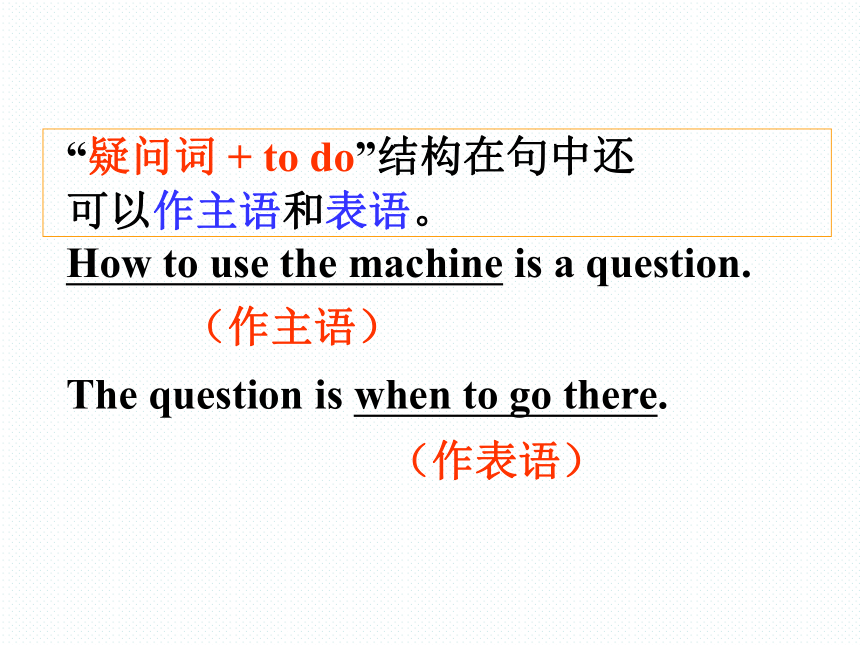
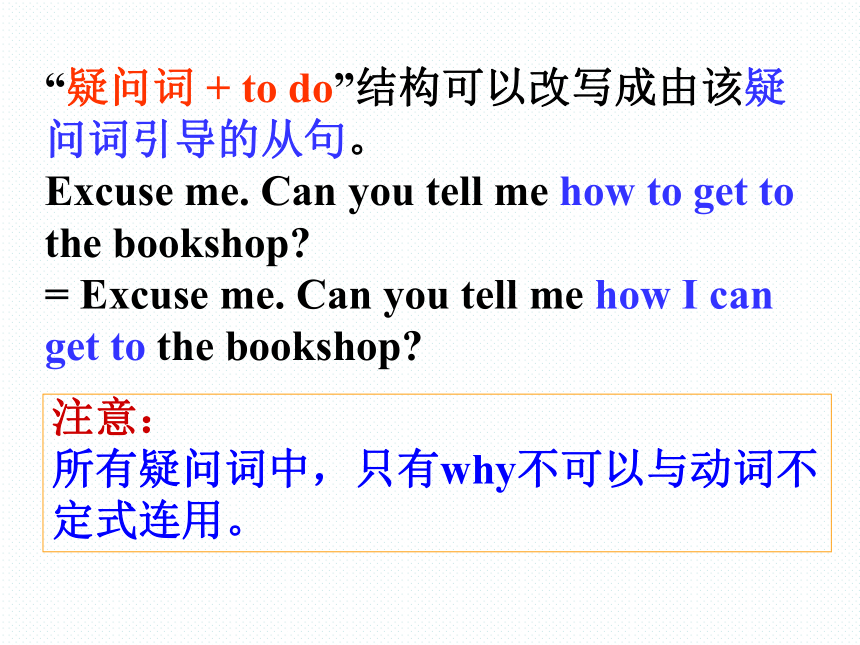
文档简介
Unit
4
A
good
read
1.
To
learn
to
use
the
structure:
question
words
+
to-infinitives
2.
To
learn
to
use
must
and
have
to
3.
To
learn
the
new
words
and
expressions
Words:
hand
review
return
Phrases:
hand
in
write
about
and
so
on
ask
for
help
with
writing
on
time
Patterns:
Millie
has
decided
what
to
read.
Sandy
is
wondering
where
to
ask
for
help.
You
must
not
smoke
in
the
library.
I
have
to
use
them
to
reach
the
box
on
the
fridge.
Using
question
words
+
to-infinitives
The
young
woman
doesn’t
know
what
to
do.
那位年轻女子不知道怎么办。
I
cannot
decide
which
to
take.
我不能决定该拿哪一个。
We
must
learn
how
to
operate
the
machine.
我们必须学习如何操作这机器。
Please
find
out
where
to
go
next.
请弄清接下来要去哪儿。
Don’t
forget
when
to
meet
your
friends.
别忘了何时去见你的朋友们。
He
wondered
who
to
talk
to
about
his
problem.
他想知道能和谁谈论他的问题。
常和“疑问词
+
to
do”结构连用的动词和动词短语有:tell,
think,
learn,
know,
wonder,
decide,
remember,
forget,
see,
understand,
hear,
ask,
advise,
explain,
find
out等。
The
teacher
told
the
students
how
to
do
the
experiment.
老师告诉学生如何做实验。
Can
you
show
me
how
to
make
a
paper
boat?
你能给我演示下怎样做一只纸船吗?
有些动词,如advise,
ask,
show,
teach,
tell等,其后可以接双宾语。
有些疑问词,如what,
which,
whose,
how
many,
how
much等,其后可以先接一个名词,再接动词不定式。
I
don’t
know
which
topic
to
choose.
我不知道选哪个题目。
在“疑问词
+
to
do”结构前,有时也可以是如sure,
clear等形容词。
I
am
not
sure
which
way
to
take.
我不确定走哪条路。
“疑问词
+
to
do”结构在句中还
可以作主语和表语。
How
to
use
the
machine
is
a
question.
(作主语)
The
question
is
when
to
go
there.
(作表语)
“疑问词
+
to
do”结构可以改写成由该疑问词引导的从句。
Excuse
me.
Can
you
tell
me
how
to
get
to
the
bookshop?
=
Excuse
me.
Can
you
tell
me
how
I
can
get
to
the
bookshop?
注意:
所有疑问词中,只有why不可以与动词不定式连用。
Amy
and
Daniel
are
talking
about
their
Reading
plete
their
conversation.
Use
the
correct
question
words
and
to-infinitives.
P55
Amy:
Mr
Wu
has
recommended
so
many
interesting
books.
Have
you
decided
(1)
____________
first,
Daniel?
Daniel:
Yes.
I
want
to
read
Black
Beauty
first.
But
I
don’t
know
(2)
___________
the
book.
how,
what,
ask
for,
find
when,
where,
hand
in,
read
which,
who,
speak,
travel,
write
about
which
to
read
where
to
find
recommend
sb
to
do
recommend
sb
as
Amy:
You
can
try
our
school
library
or
Sunshine
Library.
Oh,
did
you
know
Peter
is
reading
Around
the
World
in
Eighty
Days?
He
wants
to
find
out
(3)
____________
around
the
world
in
such
a
short
time.
Daniel:
Wow,
that’s
amazing!
By
the
way,
can
you
tell
me
(4)______________
our
book
report?
how
to
travel
when
to
hand
in
Amy:
Before
next
Friday.
I’m
still
not
sure
(5)
_________________
in
the
report.
Daniel:
You
can
write
anything
about
your
book
–
what
the
book
is
about,
what
you
think
of
it
and
so
on.
You
should
read
some
reviews
about
the
book
before
writing.
what
to
write
about
Amy:
Thank
you.
Anyway,
I
know
(6)
______________
help
with
writing.
Mr
Wu
is
always
there
to
help
us.
who
to
ask
for
which
to
read
where
to
find
how
to
travel
when
to
hand
in
what
to
write
about
who
to
ask
for
Amy
and
Daniel
are
talking
about
their
Reading
plete
their
conversation.
Use
the
correct
question
words
and
to-infinitives.
(P55)
A
何时做作业____________________
2.去哪儿__________________
3.
与谁聊天_______________________________
4.读什么
__________________
5.选多少本书
_________________________________________
6.如何去__________________
what
to
read
when
to
do
homework
how
many
books
to
choose
写出下列短语
who
to
chat
with
where
to
go
how
to
go
疑问词+动词不定式
的注意点
:
1.
不定式中的不及物动词后必要时需加上适当的介词
3.
除why以外的疑问词都可以使在这个结构中
2.有些疑问词后可以加名词
再+动词不定式
Watch
and
Observe
must
表示主观的义务和必要
have?to?强调的是客观的需要
Fill
in
the
blanks.
1.
I
_______
go
to
the
greengrocer's.
2.
He
has
a
bad
cold,
Mr.
Williams,
so
he
_____
stay
in
bed
for
a
week.
3.
“I
______
run
away
from
them,”
…
4.
Eddie,
I
think
we
_______
go
up
again.
5.
We
don’t
________
feed
her
much.
6.
I
_______
use
them
to
reach
the
box
on
the
fridge.
must
must
must
have
to
have
to
have
to
go
Ready?
Using
must
and
have
to
have?to?强调的是客观的需要,意思是“不得不”。have?to
有人称和数的变化。
Compare
must
表示主观的义务和必要,强调说话人的主观看法,主要用于肯定句和疑问句,意思是“必须,得,要”;must
还可以表示肯定猜测,意思是“一定”。
must的否定形式是must
not,其缩写为mustn’t,表示禁止,意思是“不能,不许”。
have?to的否定形式是do
not
have
to,其缩写为don’t?have?to。
You?mustn’t?make?any?noise?in?class.
上课时你们不许吵闹。
You?don’t?have?to?water?the?flowers.?
你们不必浇花了。
must
must
mustn’t
mustn’t
must
have
to
don’t
have
to
Amy
is
telling
her
cousin
Shirley
some
library
plete
what
she
says
with
must,
must
not,
have
to
or
do
not
have
to.
(P56)
B
不定式可以和疑问代词who,
what,
which及疑问副词when,
how,
where等连用,在句中作主语、宾语、表语。
1.
must表示主观的义务和必要,意思是“必须,得,要”,否定形式是must
not;
2.
must还可以表示肯定猜测,意思是“一定”。
3.
have
to表示一种客观的需要,意思是“不得不”,否定形式是do
not
have
to。
请点击
1.
I’m
going
on
a
field
trip
but
I
haven’t
decided
___________(去哪里).
2.
Excuse
me.
Would
you
please
tell
me
____________(去哪里买)
a
digital
camera?
3.
This
physics
problem
is
too
difficult.
Can
you
show
me
________
(如何)
work
it
out?
I.
根据提示填空。
where
to
go
where
to
buy
how
to
4.
—
We
need
a
new
leader
for
our
Helping
Hands
Club,
but
I
don’t
know
_____________(选择谁).
—
Why
not
Mary?
She
is
always
willing
to
help
others.
5.
—
Excuse
me.
Could
you
tell
me
______(如何)
get
to
the
nearest
post
office?
—
Sorry,
I
am
new
here.
who
to
choose
how
to
6.
—
Excuse
me.
Could
you
please
tell
me
____________
(停到哪里)
my
car?
—
Sure.
Park
it
right
here.
I’ll
help
you.
7.
—
May
I
swim
here?
—
I’m
sorry.
Children
_______(禁止)
swim
alone
here.
8.
Students
in
our
school
______
know
shouting
is
not
allowed
in
the
library.
where
to
park
mustn’t
must
When
I
go
into
the
clothes
shop,
I
always
can’t
decide
______
one
to
buy.
2.
My
grandfather
doesn’t
know
______
to
use
a
computer.
3.
—
Will
you
please
show
me
_____
to
drive
a
car?
—
Yes,
of
course.
Now
let
me
tell
you
_____
to
do
first.
4.
I
will
tell
Lucy
______
and
_______
to
meet.
which
how
how
what
when
where
II.
选用how,
which,
what,
when,
where填空。
IV.
翻译下列句子。
1.
Have
you
decided
_____________
____________
(怎样度假)?
2.
I
don’t
know
______________________
(在会上说什么).
3.
Can
you
tell
me
___________________
(在哪里能买到这本书)?
your
holiday
how
to
spend
what
to
say
at
the
meeting
where
to
buy
this
book
1.
Write
some
sentences
that
you
(or
your
friends
or
family)
must/mustn’t
do
or
have
to/don’t
have
to
do.
2.
Preview
Integrated
skills
on
Pages
57
and
58.
Homework
4
A
good
read
1.
To
learn
to
use
the
structure:
question
words
+
to-infinitives
2.
To
learn
to
use
must
and
have
to
3.
To
learn
the
new
words
and
expressions
Words:
hand
review
return
Phrases:
hand
in
write
about
and
so
on
ask
for
help
with
writing
on
time
Patterns:
Millie
has
decided
what
to
read.
Sandy
is
wondering
where
to
ask
for
help.
You
must
not
smoke
in
the
library.
I
have
to
use
them
to
reach
the
box
on
the
fridge.
Using
question
words
+
to-infinitives
The
young
woman
doesn’t
know
what
to
do.
那位年轻女子不知道怎么办。
I
cannot
decide
which
to
take.
我不能决定该拿哪一个。
We
must
learn
how
to
operate
the
machine.
我们必须学习如何操作这机器。
Please
find
out
where
to
go
next.
请弄清接下来要去哪儿。
Don’t
forget
when
to
meet
your
friends.
别忘了何时去见你的朋友们。
He
wondered
who
to
talk
to
about
his
problem.
他想知道能和谁谈论他的问题。
常和“疑问词
+
to
do”结构连用的动词和动词短语有:tell,
think,
learn,
know,
wonder,
decide,
remember,
forget,
see,
understand,
hear,
ask,
advise,
explain,
find
out等。
The
teacher
told
the
students
how
to
do
the
experiment.
老师告诉学生如何做实验。
Can
you
show
me
how
to
make
a
paper
boat?
你能给我演示下怎样做一只纸船吗?
有些动词,如advise,
ask,
show,
teach,
tell等,其后可以接双宾语。
有些疑问词,如what,
which,
whose,
how
many,
how
much等,其后可以先接一个名词,再接动词不定式。
I
don’t
know
which
topic
to
choose.
我不知道选哪个题目。
在“疑问词
+
to
do”结构前,有时也可以是如sure,
clear等形容词。
I
am
not
sure
which
way
to
take.
我不确定走哪条路。
“疑问词
+
to
do”结构在句中还
可以作主语和表语。
How
to
use
the
machine
is
a
question.
(作主语)
The
question
is
when
to
go
there.
(作表语)
“疑问词
+
to
do”结构可以改写成由该疑问词引导的从句。
Excuse
me.
Can
you
tell
me
how
to
get
to
the
bookshop?
=
Excuse
me.
Can
you
tell
me
how
I
can
get
to
the
bookshop?
注意:
所有疑问词中,只有why不可以与动词不定式连用。
Amy
and
Daniel
are
talking
about
their
Reading
plete
their
conversation.
Use
the
correct
question
words
and
to-infinitives.
P55
Amy:
Mr
Wu
has
recommended
so
many
interesting
books.
Have
you
decided
(1)
____________
first,
Daniel?
Daniel:
Yes.
I
want
to
read
Black
Beauty
first.
But
I
don’t
know
(2)
___________
the
book.
how,
what,
ask
for,
find
when,
where,
hand
in,
read
which,
who,
speak,
travel,
write
about
which
to
read
where
to
find
recommend
sb
to
do
recommend
sb
as
Amy:
You
can
try
our
school
library
or
Sunshine
Library.
Oh,
did
you
know
Peter
is
reading
Around
the
World
in
Eighty
Days?
He
wants
to
find
out
(3)
____________
around
the
world
in
such
a
short
time.
Daniel:
Wow,
that’s
amazing!
By
the
way,
can
you
tell
me
(4)______________
our
book
report?
how
to
travel
when
to
hand
in
Amy:
Before
next
Friday.
I’m
still
not
sure
(5)
_________________
in
the
report.
Daniel:
You
can
write
anything
about
your
book
–
what
the
book
is
about,
what
you
think
of
it
and
so
on.
You
should
read
some
reviews
about
the
book
before
writing.
what
to
write
about
Amy:
Thank
you.
Anyway,
I
know
(6)
______________
help
with
writing.
Mr
Wu
is
always
there
to
help
us.
who
to
ask
for
which
to
read
where
to
find
how
to
travel
when
to
hand
in
what
to
write
about
who
to
ask
for
Amy
and
Daniel
are
talking
about
their
Reading
plete
their
conversation.
Use
the
correct
question
words
and
to-infinitives.
(P55)
A
何时做作业____________________
2.去哪儿__________________
3.
与谁聊天_______________________________
4.读什么
__________________
5.选多少本书
_________________________________________
6.如何去__________________
what
to
read
when
to
do
homework
how
many
books
to
choose
写出下列短语
who
to
chat
with
where
to
go
how
to
go
疑问词+动词不定式
的注意点
:
1.
不定式中的不及物动词后必要时需加上适当的介词
3.
除why以外的疑问词都可以使在这个结构中
2.有些疑问词后可以加名词
再+动词不定式
Watch
and
Observe
must
表示主观的义务和必要
have?to?强调的是客观的需要
Fill
in
the
blanks.
1.
I
_______
go
to
the
greengrocer's.
2.
He
has
a
bad
cold,
Mr.
Williams,
so
he
_____
stay
in
bed
for
a
week.
3.
“I
______
run
away
from
them,”
…
4.
Eddie,
I
think
we
_______
go
up
again.
5.
We
don’t
________
feed
her
much.
6.
I
_______
use
them
to
reach
the
box
on
the
fridge.
must
must
must
have
to
have
to
have
to
go
Ready?
Using
must
and
have
to
have?to?强调的是客观的需要,意思是“不得不”。have?to
有人称和数的变化。
Compare
must
表示主观的义务和必要,强调说话人的主观看法,主要用于肯定句和疑问句,意思是“必须,得,要”;must
还可以表示肯定猜测,意思是“一定”。
must的否定形式是must
not,其缩写为mustn’t,表示禁止,意思是“不能,不许”。
have?to的否定形式是do
not
have
to,其缩写为don’t?have?to。
You?mustn’t?make?any?noise?in?class.
上课时你们不许吵闹。
You?don’t?have?to?water?the?flowers.?
你们不必浇花了。
must
must
mustn’t
mustn’t
must
have
to
don’t
have
to
Amy
is
telling
her
cousin
Shirley
some
library
plete
what
she
says
with
must,
must
not,
have
to
or
do
not
have
to.
(P56)
B
不定式可以和疑问代词who,
what,
which及疑问副词when,
how,
where等连用,在句中作主语、宾语、表语。
1.
must表示主观的义务和必要,意思是“必须,得,要”,否定形式是must
not;
2.
must还可以表示肯定猜测,意思是“一定”。
3.
have
to表示一种客观的需要,意思是“不得不”,否定形式是do
not
have
to。
请点击
1.
I’m
going
on
a
field
trip
but
I
haven’t
decided
___________(去哪里).
2.
Excuse
me.
Would
you
please
tell
me
____________(去哪里买)
a
digital
camera?
3.
This
physics
problem
is
too
difficult.
Can
you
show
me
________
(如何)
work
it
out?
I.
根据提示填空。
where
to
go
where
to
buy
how
to
4.
—
We
need
a
new
leader
for
our
Helping
Hands
Club,
but
I
don’t
know
_____________(选择谁).
—
Why
not
Mary?
She
is
always
willing
to
help
others.
5.
—
Excuse
me.
Could
you
tell
me
______(如何)
get
to
the
nearest
post
office?
—
Sorry,
I
am
new
here.
who
to
choose
how
to
6.
—
Excuse
me.
Could
you
please
tell
me
____________
(停到哪里)
my
car?
—
Sure.
Park
it
right
here.
I’ll
help
you.
7.
—
May
I
swim
here?
—
I’m
sorry.
Children
_______(禁止)
swim
alone
here.
8.
Students
in
our
school
______
know
shouting
is
not
allowed
in
the
library.
where
to
park
mustn’t
must
When
I
go
into
the
clothes
shop,
I
always
can’t
decide
______
one
to
buy.
2.
My
grandfather
doesn’t
know
______
to
use
a
computer.
3.
—
Will
you
please
show
me
_____
to
drive
a
car?
—
Yes,
of
course.
Now
let
me
tell
you
_____
to
do
first.
4.
I
will
tell
Lucy
______
and
_______
to
meet.
which
how
how
what
when
where
II.
选用how,
which,
what,
when,
where填空。
IV.
翻译下列句子。
1.
Have
you
decided
_____________
____________
(怎样度假)?
2.
I
don’t
know
______________________
(在会上说什么).
3.
Can
you
tell
me
___________________
(在哪里能买到这本书)?
your
holiday
how
to
spend
what
to
say
at
the
meeting
where
to
buy
this
book
1.
Write
some
sentences
that
you
(or
your
friends
or
family)
must/mustn’t
do
or
have
to/don’t
have
to
do.
2.
Preview
Integrated
skills
on
Pages
57
and
58.
Homework
